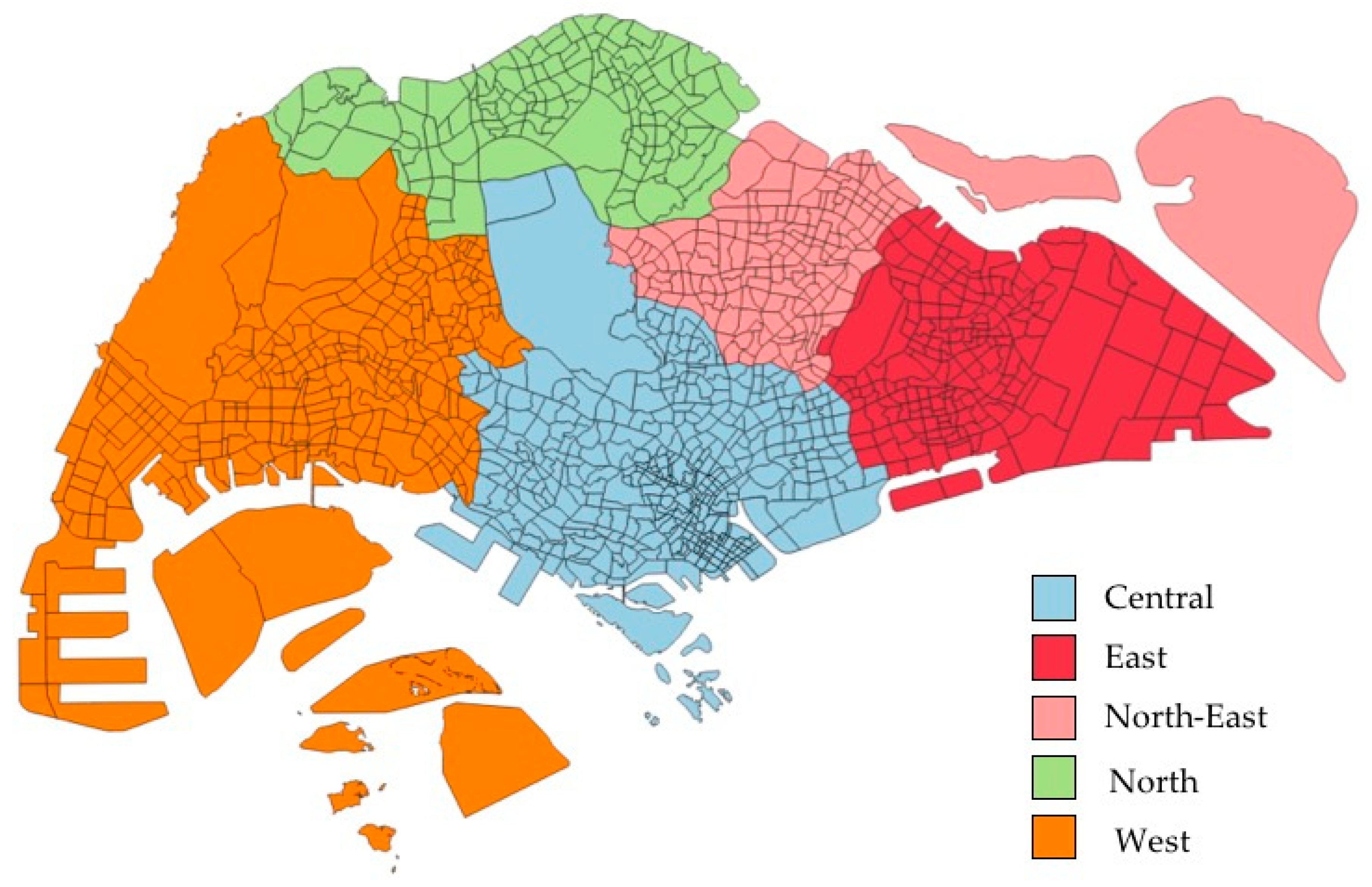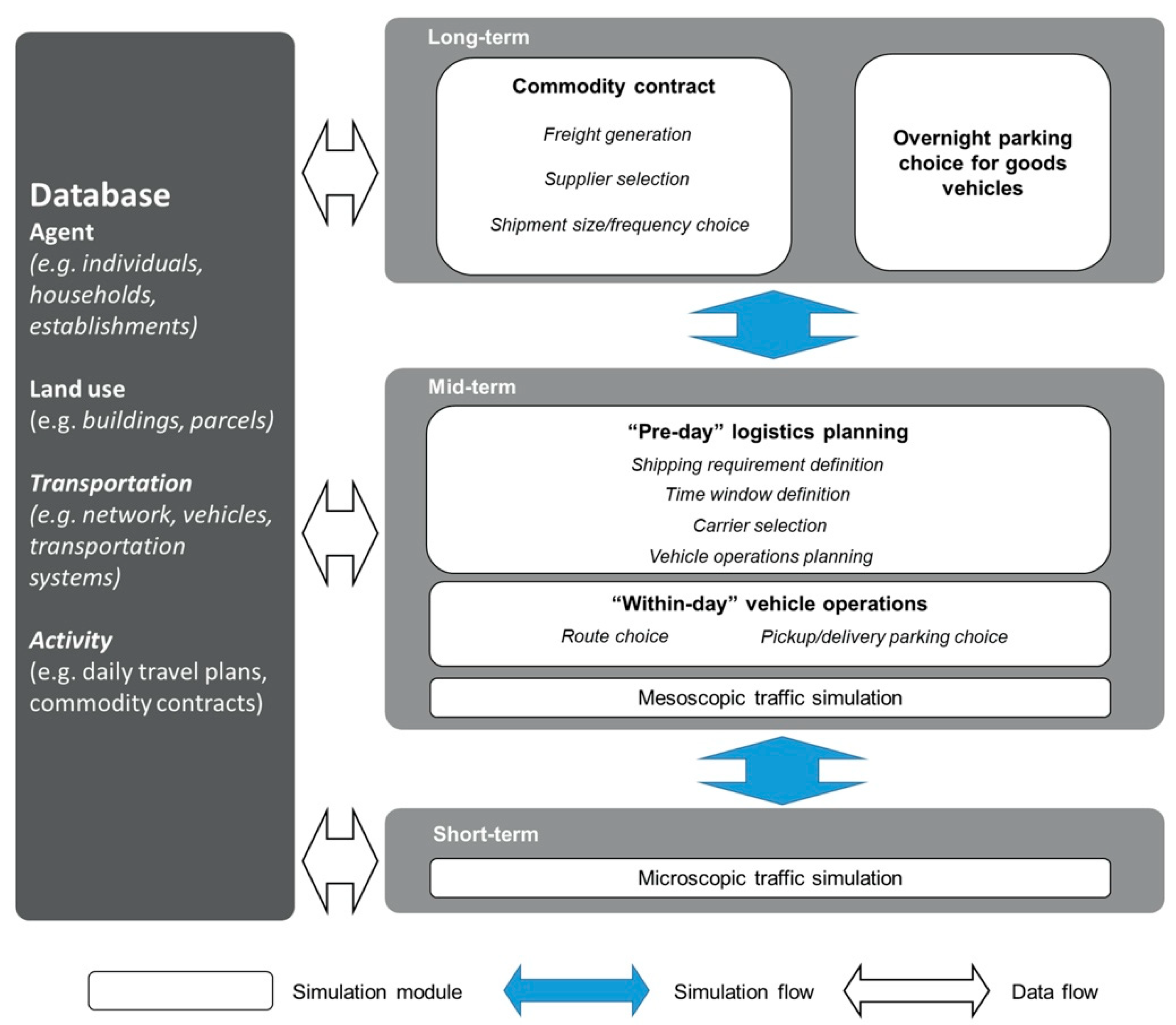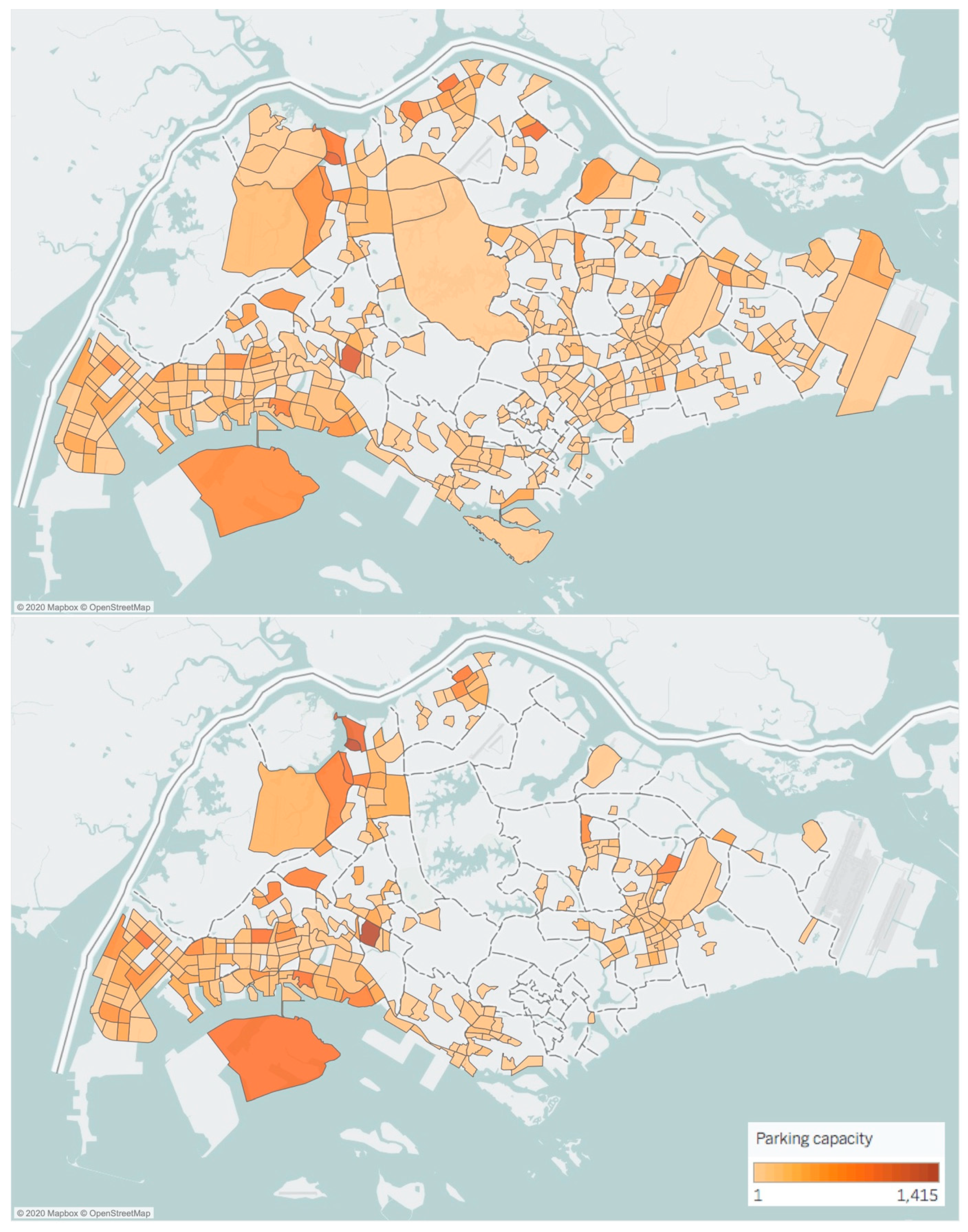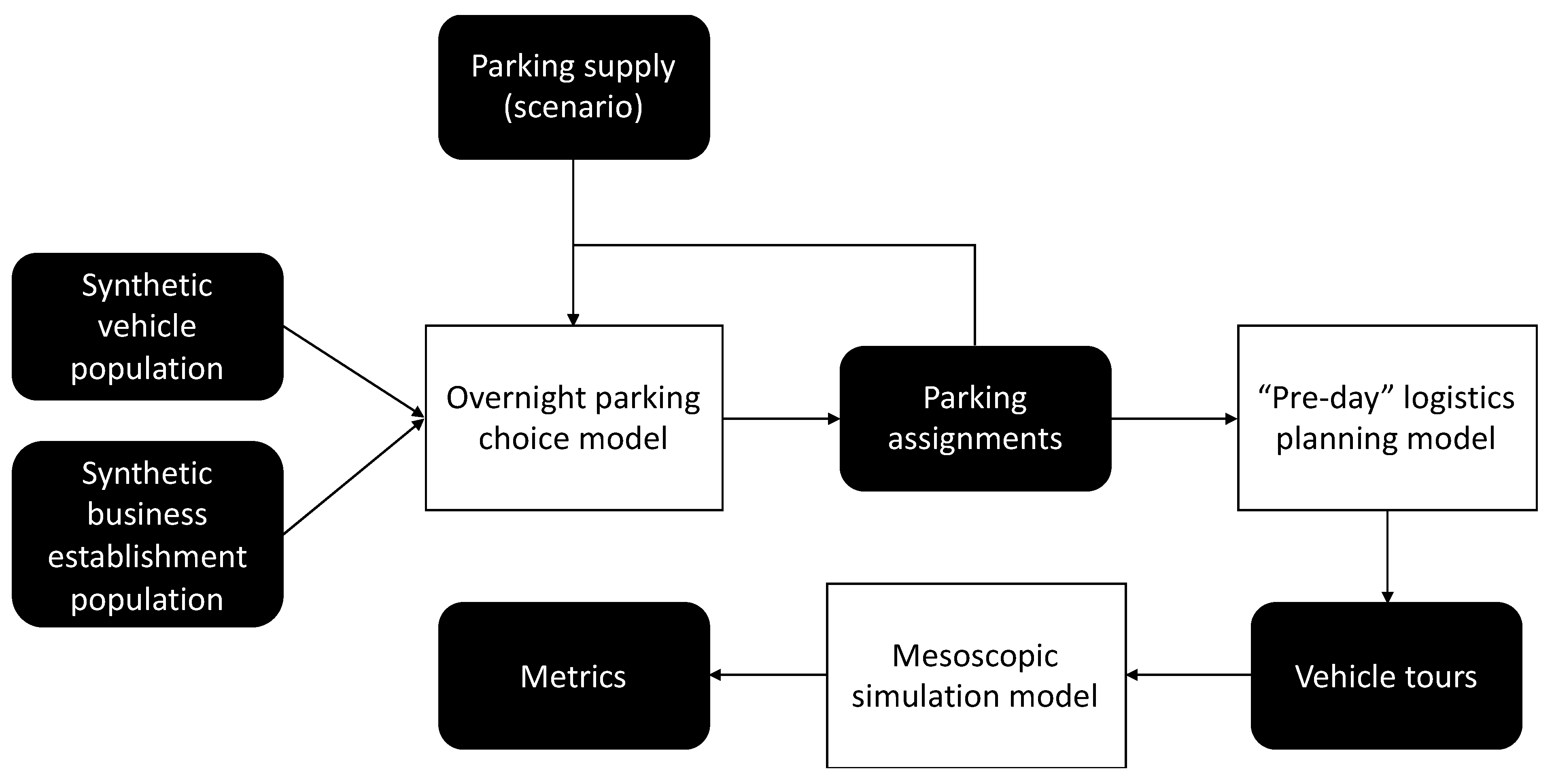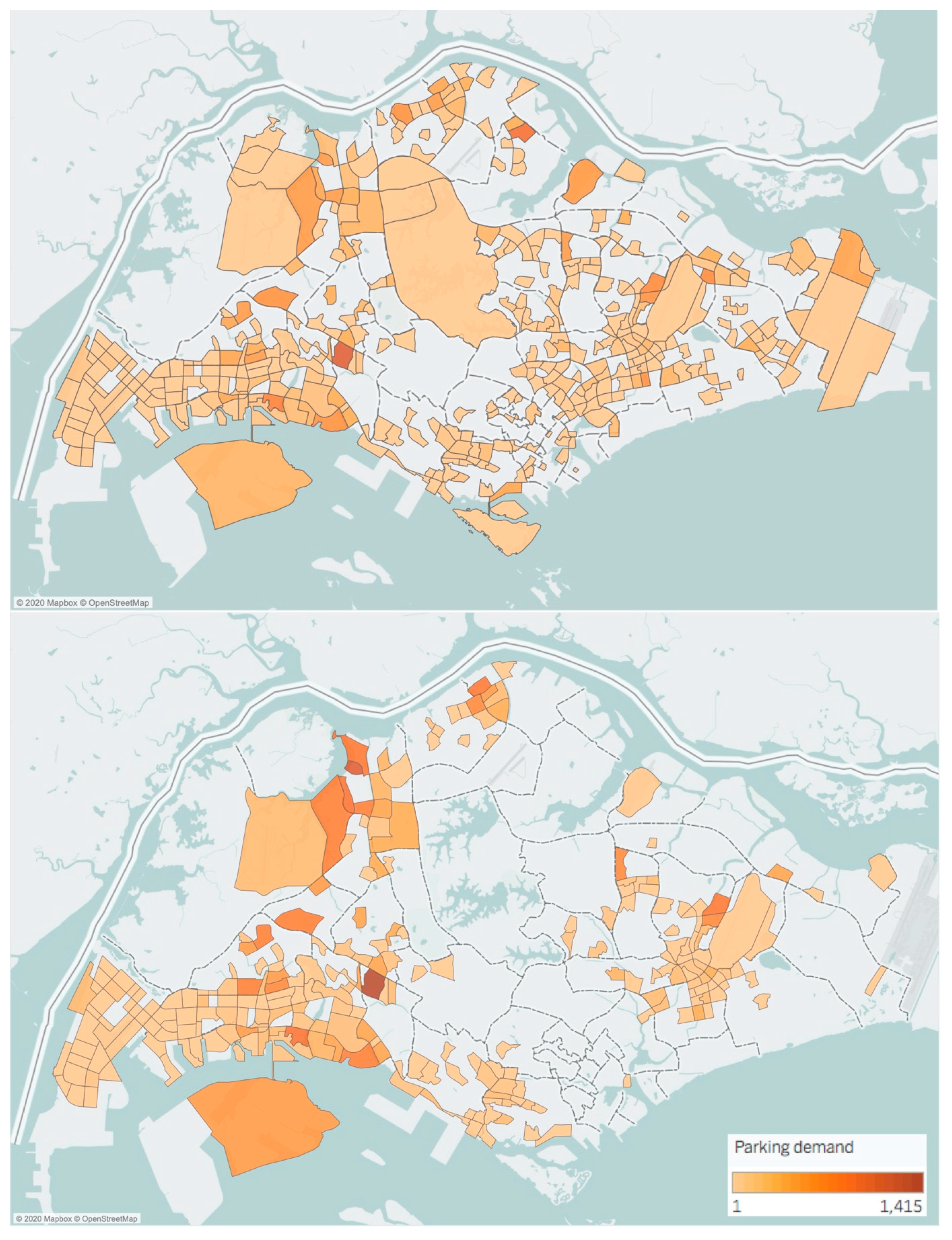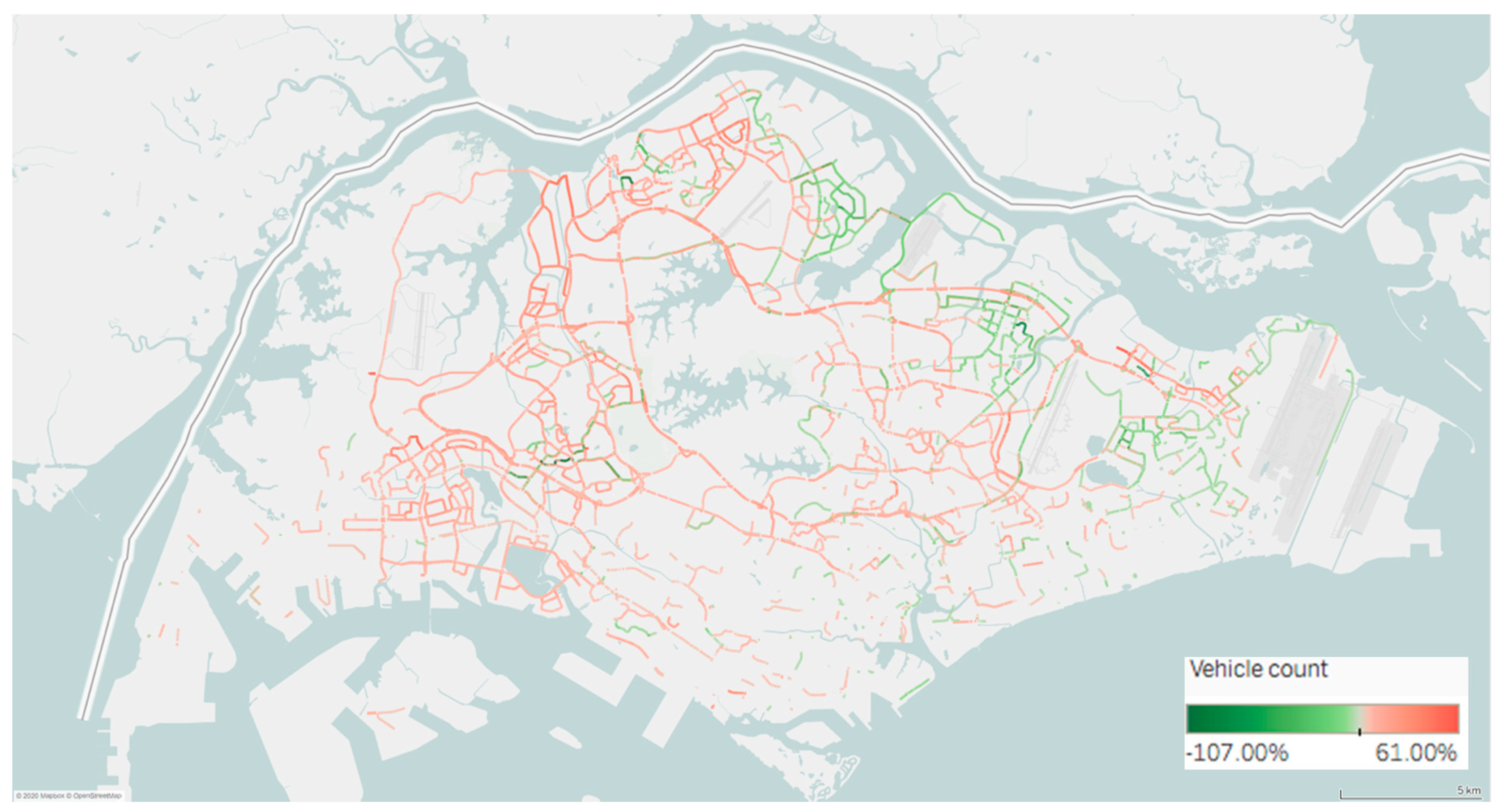1. Introduction
The rapid urbanization and structural change in logistics, such as the proliferation of just-in-time inventory management practices and growth in e-commerce, have led to a significant increase in urban freight movements around the world [
1]. Commercial vehicles dominantly serve the first and last miles of supply chains in most cities [
2]. Trucks, vans, prime movers and tankers are typical examples of commercial vehicles fulfilling urban freight movements. The contributions of commercial vehicles to road traffic and air pollution are known to be disproportionally high compared with other vehicles [
3]. These negative impacts of commercial vehicle trips are of concern to urban planners.
The distribution of overnight parking facilities within cities partially determines commercial vehicle traffic, as vehicles are parked at such facilities during inactive periods. In this paper, we distinguish the parking activity at the end of a work shift in a dedicated parking facility as “overnight parking”, and parking at other locations as “in-operation parking”. Furthermore, we define a vehicle tour as a sequence of stops starting and terminating at an “overnight parking” location interspersed with one or more “in-operation parking” locations.
Vehicle owners and operators might have different goals when it comes to overnight parking. The overnight parking location affects the total distance and time traveled, and thus the operating cost of a commercial vehicle. A suboptimal choice of parking location might lead to an infructuous empty trip if the vehicle is not parked close to or at a frequent pickup location, or if pickup locations change frequently. Furthermore, urban planners are often motivated to improve the efficiency of land-use. While earmarking land for overnight parking is one of the policy measures available to them, it is a challenge to measure the social benefit associated with changes in parking supply.
The literature on commercial vehicle parking is limited and primarily focused on in-operation parking (i.e., pickup and delivery). It can be broadly distinguished into analytical and simulation-based approaches. The former examines the economics of parking by evaluating in-operation parking policies. Arnott and Inci [
4] analyze the trade-off between car parking price, parking supply and cruising for finding a parking space, under the assumption of homogenous drivers and a Manhattan Street Network. Their analysis indicates that setting the parking price at a level which eliminates cruising maximizes social surplus, while an increase in curbside parking supply is the second-best policy. Amer and Chow [
5] propose an analytical model for truck delivery parking, where small delivery trucks and passenger vehicles compete for the same curbside parking supply. They evaluate the impact of limited parking capacity on the cruising behavior of cars, and on delivery trucks’ double parking, with the objective of assessing the trade-offs between parking spaces, pricing and congestion. They apply the model to a representation of downtown Toronto, assuming homogeneous agents and a Manhattan Street Network. While analytical models provide valuable insights on the impact of parking policies, the results might not hold under the assumptions of homogenous agents and of a Manhattan Street Network, especially when the study area is extended to an entire city. In such cases, a simulation-based approach is more appropriate to evaluate parking policies.
Simulation-based approaches have been widely used to assess the impacts of policies related to in-operation parking of commercial vehicles. Marcucci et al. [
6] analyze the impact of pricing policies on the availability of loading and unloading bays for commercial vehicles. Alho et al. [
7] evaluate strategies to reduce double parking attributable to the unavailability of loading bays. Nourinejad et al. [
8] use traffic simulation to assess the impact of commercial vehicle parking policies in the central business district of Toronto. Benenson et al. [
9] use PARKAGENT, an agent-based simulator, to assess the impact of an off-street overnight car parking facility on the distribution of walking distance and search time for existing on-street parking spaces. Using data from Tel Aviv, they demonstrate that minor additions to parking capacity do not affect the distribution of parking search time and walking distance when the overall parking demand significantly exceeds parking supply.
While the in-operation parking behavior of commercial vehicles in urban areas has been studied, there are only a few studies focusing on overnight commercial vehicle parking. Wong et al. [
10] estimate the total parking demand in Hong Kong for both passenger and commercial vehicles. Using the data collected from a stated preference survey, they develop aggregate econometric models for forecasting parking demand. However, they do not consider agent heterogeneity in the model. Furthermore, they do not study the effect of changes in parking supply and subsequent demand on resulting traffic. Lau et al. [
11] updated and recalibrated the models developed in [
10] using data from a follow-on survey, and present revised parking demand forecasts for Hong Kong.
In conclusion, there is a knowledge gap in the relationship between parking supply and the operational efficiency of commercial vehicles, as well as in revealing associated negative externalities, such as traffic congestion and emissions. To contribute towards our understanding of these relationships, we propose the use of an overnight parking choice model, integrated with an agent-based urban freight simulator. This allows us to evaluate traffic impacts of various parking supply scenarios, specifically, the extent of inefficiency introduced in vehicle tours due to overnight parking choice, such as the empty trips from overnight parking locations to pick-up and delivery points. In this paper, we detail such a case study for the island-state of Singapore, leveraging an existing agent-based urban freight simulator—SimMobility [
12,
13]—inclusive of its land-use models, to analyze traffic impacts associated with different overnight parking supply scenarios.
2. Methods and Data
2.1. Case Study Description
The study area, Singapore, covers an area of 719.9 km
2 with a population of 5.6 million and a GDP of USD 311 billion [
14]. As a hub of economic activity, Singapore hosts one of the largest financial centers in the Southeast Asia region and has large freight generators such as a container port, an airport, logistics facilities, and two large oil refineries within its territory. Singapore is a dense island-nation and an ideal test bed to study the impact of changing parking infrastructure due to its closed-system nature when compared with other cities. At the end of each workday, most commercial vehicles will remain within the city boundaries.
Singapore has a registered vehicle population of over 950,000 of which 144,000 are commercial vehicles [
15]. Within the population of commercial vehicles, 112,000 are light commercial vehicles (LCVs) while the remaining 32,000 are categorized as heavy commercial vehicles (HCVs). A commercial vehicle is categorized as such if its maximum laden weight (MLW) is more than five metric tons (MT). The definition still covers a wide range of carrying capacities, body types and industries served. For example, MLW of trucks may range from 5 MT to 34 MT. Body types include refrigerated trucks, articulated vehicles, cranes, construction vehicles, etc., and there are multiple industries served by these vehicles such as construction, wholesale, retail, warehousing, agriculture etc. Unlike LCVs, which can share parking facilities with cars, HCVs require dedicated facilities to accommodate their larger size. HCV parking provision tends to be land resource-intensive, requiring planning attention. This means that a non-negligible share of vehicle owners and operators might not be able to park in their preferred location, having to select an overnight parking location due to multiple factors, such as the cost of subscription and drivers’ accessibility of parking lot to drivers, and from lot to business locations. Therefore, in this paper, we focus on the impact of redistributing the HCV parking supply.
The parking supply for HCV consists of approximately 41,800 HCV parking spaces. It is owned by parking operators categorized into four types: public 1, public 2, private–open and private–closed. The public 1 and public 2 parking lots together constitute 26% of the total parking supply, and are operated by two large public entities in Singapore. In contrast, there are over 3500 individual private parking operators. For these, each parking lot is considered private–open when it is accessible to vehicles belonging to any owner, and private–closed otherwise. The share of private–open parking lots amounts to 14% of the overall private parking supply, with the remaining categorized as private–closed. We assumed lots with subscription prices found online as private–open, and those without as private–closed.
HCV parking supply and commercial vehicle registry data were obtained from official sources in Singapore. Singapore law requires HCV vehicle owners to report a monthly subscription to the transport authority detailing a designated overnight parking location for every HCV. The characterization of a baseline HCV parking supply and demand scenario was possible by matching these two datasets. Information on land-use type (industrial, residential, commercial etc.) was obtained from the Singapore Master Plan [
16], and referred to for the development of alternative parking supply scenarios.
In this study, we use traffic analysis zones (TAZs) as the spatial unit for parking demand and supply. Singapore is divided into 1169 TAZs distributed across five regions: North, East, West, Central, and Northeast. The HCV parking supply is distributed in 526 TAZs. These regions are illustrated in
Figure 1.
2.2. Overnight Parking Choice Model
The parking subscription of an HCV is modeled using a multinomial logit model framework. For computational efficiency, the overnight parking locations are aggregated into a set of composite parking alternatives. The composite alternatives are defined by park ownership type (public 1, public 2, private–open and private–closed) and TAZ. The spatial aggregation results in 539 unique TAZ–park ownership type alternatives, with 78 TAZs in public 1, 44 in public 2, 100 in private–open and 317 in private–closed. It is assumed that the elementary alternatives in a composite alternative, i.e., parking lots of the same park type in a TAZ, are equally likely to be chosen.
We hypothesize that the overnight parking location choice of HCVs is influenced by factors such as the distance of parking lot to the vehicle owner’s location, the industry category of the vehicle owner, vehicle characteristics, and price of parking. We do not have suitable individual vehicle-level information on freight pick-up locations or drivers’ residential addresses to compute unbiased accessibility measures. HCV freight pick-up locations are often manufacturing units or large warehouses located in industrial areas. Furthermore, vehicles with different MLW are assumed to differ in sensitivity to park ownership type. A dummy variable for parking operator type is included to account for differences in preferences for different park operators.
The vehicle owner derives a random utility by parking a vehicle
n in a composite alternative
j, which is defined as a function, linear in parameters, of the attributes of the parking alternative and vehicle characteristics. Parking capacity of the composite alternative is included as a size variable resulting from the aggregation of elementary alternatives [
17]. The utility of parking,
, is defined as the sum of a systematic component,
, and a random error term,
, as follows:
where
: Parameters to be estimated
: Park ownership type dummy variable (public 1, public 2, private–open and private–closed)
: Distance from the owner location of vehicle n to parking alternative j
: Monthly parking subscription price for parking alternative j
: MLW of vehicle n
: Age of vehicle n
: Industry category of owner of vehicle n
: Size variable of parking alternative j
: Parking choice of vehicle n
: i.i.d. Type-I extreme value (Gumbel) distributed error term
We observe the dependent variable,
, and the other attributes described above. The probability of a vehicle
n selecting location
j from a choice set
is given by the following expression [
18]:
The parameters of the utility function are estimated by maximum likelihood estimation with a sample size of 1000 HCVs. The results are detailed in the “Results” section.
2.3. Simulation
2.3.1. SimMobility Overview
SimMobility is an agent-based, multitemporal, multiactivity urban simulation platform for evaluating land-use changes and passenger and freight mobility. It is an integrated simulator with a consistent set of agents: individuals, establishments and drivers across both the passenger and freight modules. A synthetic population of individuals, establishments and vehicles is constructed in SimMobility [
18] and used in this study.
SimMobility Freight [
13] as displayed in
Figure 2, is a component of SimMobility, which covers the simulations of commodity flows, overnight parking subscription decisions, logistics planning, and driver-level behaviors. Commodity contracts and shipments influence “pre-day” logistics planning such as carrier selection and vehicle operation planning. Along with overnight parking decisions, these are the inputs for simulating vehicle-level behaviors. Network traffic is simulated in a mesoscopic simulator, in which the decisions on route choice are simulated for each vehicle. The inputs to the overnight parking module are the overnight parking supply, synthetic population of vehicles, and vehicle-owning establishments. The impact of changes in overnight parking supply on traffic is assessed using SimMobility.
2.3.2. HCV Parking Supply Scenarios
To estimate the impact of changing HCV parking supply, we set two supply scenarios: a baseline and a hypothetical parking supply scenario. Hereafter, the baseline will be referred to as Scenario 1 and the hypothetical scenario as Scenario 2. We hypothesize that shifting parking locations closer to major industrial areas, will: (a) release the scarce land resources in nonindustrial areas; (b) segregate the HCV parking supply, reducing interactions of HCVs with cars and thereby increasing safety [
19], particularly for the trips to and from the overnight parking location; and (c) ameliorate air quality in nonindustrial areas as the HCV traffic has an adverse effect on air pollution [
20].
In Scenario 1, HCV supply consisting of 41,800 parking spaces is distributed to 3560 parking locations that spread over 379 TAZs. In Scenario 2, the total number of parking spaces is kept constant, but parking capacities at the locations in the Scenario 1 are redistributed based on a measure of proximity to industrial areas. In Scenario 2, the 41,800 parking spaces are distributed into 2910 parking locations across 236 TAZs. In effect, for Scenario 2, there are fewer but larger parking lots predominantly in the industrial areas of Singapore’s Western region. The HCV parking supply scenarios are shown in
Figure 3.
2.3.3. Simulation Setup
The simulation setup is summarized in
Figure 4. Considering the given overnight parking supply infrastructure scenario, we applied the overnight parking choice model to obtain overnight parking assignments. Iterating over vehicles randomly, and taking vehicle attributes as well of those of their owner as inputs, the utility of available parking alternatives is calculated, and the alternative with the largest utility is assigned to the vehicle. Note that the parking alternatives are the composite alternatives prior described, defined by park-ownership type (
public 1,
public 2,
private–open and
private–closed) and TAZ membership. Thus, upon selection of the alternative, a random assignment is performed on the subalternative at the TAZ level. Following, the capacity of the given alternative is reduced by one. Upon obtaining parking assignments for all vehicles, the planning for their tours takes place. Note that to measure the isolated impact of changing overnight parking supply for HCVs, we fixed commodity contracts and shipments, vehicle ownership, and vehicle operation plans which determine activity locations during the simulation for both scenarios. The vehicle operations plan for HCVs in Scenario 1 is determined by running the “pre-day” module in SimMobility. In Scenario 2, only the overnight parking locations of the vehicles are changed. The other activity locations in the vehicle tours are retained. The only impact on trips other than first and last trips, which originate or terminate at an overnight parking location, is due to the randomness incorporated in the dynamic route choice simulations.
2.3.4. Metrics of Interest
The two scenarios are compared in terms of a few performance measures. We compute, for each vehicle, the length of trips to and from the overnight parking location under the assumption that the remaining trips on the vehicle tour are fixed. As mentioned earlier, a vehicle tour is a sequence of stops starting and terminating at an overnight parking location. The sum of these trip lengths is an proxy of the change in negative impacts such as pollution and energy consumption associated with trips to and from the overnight parking location. Furthermore, we compute changes in HCV traffic for different segments of the road network which can help to identify potential traffic bottlenecks.
3. Results
In this section, the estimated overnight parking choice model is detailed, followed by an examination of the outcomes of its application to the alternative parking supply scenario—Scenario 2—and the resulting traffic flows and associated metrics. The parameters of the estimated overnight parking choice model are summarized in
Table 1.
The initial loglikelihood is equal to –5437.6, and the final equal to –4456.6. Thus, the log-likelihood ratio index (see, e.g., [
21]) is 0.175, which is comparable to the results of spatial choice models found in literature ([
22,
23]). The results indicate that vehicle owners prefer parking at locations closer to their own business, which is seen in the negative coefficients for distance. Furthermore, as expected, owners are sensitive to changes in parking prices as reflected in the negative price elasticities. Owners with heavier vehicles (such as cranes, etc.), and those in the transportation industry are unlikely to park in
private–closed parking locations. This can be related to locations of demand for these vehicles varying over time, thereby requiring a shift in the overnight parking location. In contrast, owners of manufacturing industry vehicles prefer
private–closed parking, which is not surprising as the vehicles might potentially be closer to the first pick-up location. Older commercial vehicles tend to park in
public 1 parking locations, which often have advantages such as a convenient location, a low parking fee and a first-in/first-out policy of allocation.
Applying the overnight parking choice model to the parking supply in Scenario 2 results in the spatial distribution of realized demand shown in
Figure 5. Note this figure details the realized demand, meaning it considers supply constraints in the assignment of demand to supply. Furthermore,
Table 2 summarizes the changes in region-wise utilization of parking supply in Singapore. Due to the redistribution of parking spaces primarily to the West of Singapore, the utilization rate of parking lots increases in the Central, East and Northeast regions of Singapore, and decreases in the North region.
Three iterations of the traffic simulation were performed in SimMobility and the traffic flow results were found to be stable across the runs. The total vehicle kilometers travelled (VKT) by all HCVs in a day increased by 7%, from 1,869,029 km in Scenario 1 to 2,000,783 km in Scenario 2, indicating a longer distance traveled by the vehicles to fulfill the same commodity flows. The sum of the first and last trip lengths increased across the scenarios by 36%, from 20.44 km in Scenario 1 to 27.81 km in Scenario 2, indicating an adverse impact on the vehicle operating costs. Furthermore, the HCV traffic on the road network increased in the industrial areas in the West, and decreased by a small amount in HCV traffic in the East and Central regions of Singapore as shown in
Figure 6. This is not surprising, as the parking supply increased primarily in the industrial areas in the West. We also compared the change in speed across scenarios for the different segments of the network. There was a negligible change, which was expected, as HCVs (32,000) constitute only 3% of the total vehicle population of Singapore. We found that a shift in overnight parking provision away from nonindustrial areas fulfils the objective of segregating HCV traffic in Central and Eastern regions. Furthermore, it makes land in nonindustrial areas available for other purposes. However, this results in an increase in VKT to fulfill the same amount of commodity flows within the city.
